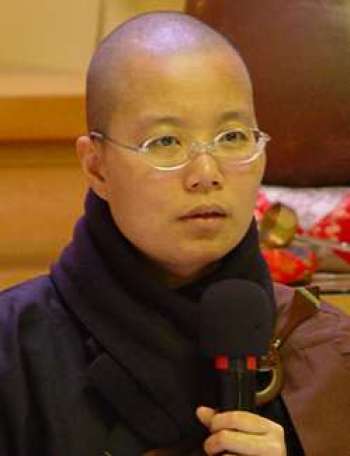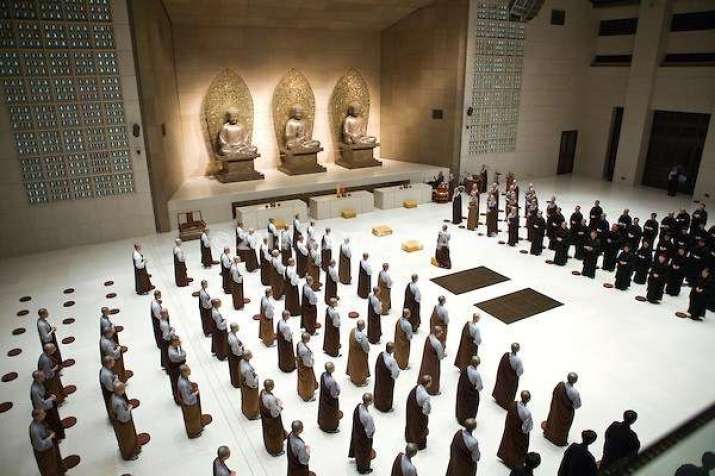I did not have an opportunity to learn about Buddhism until 1993, during my second year of graduate school in the United States. I remember that on the last day of our finals for that year, I told myself that I needed to make a decision on how I was going to continue my graduate studies. I felt mistreated by my advisor and I didn’t think I could go through it to finish my graduate studies. I therefore had a choice: change advisor or quit school.
 Ven. Chang-Hwa. Image courtesy of the author
Ven. Chang-Hwa. Image courtesy of the authorAfter interviews with many professors, I was fortunate to find one—and only one—brave professor to be my new advisor, and who did not care about offending my then-famous previous advisor. An MIT graduate, she was a white American female, and single. As a vegetarian, she ate the same kind of cheese sandwich, day after day, year after year, carried in a sandwich bag that she reused over and over. That year, my research changed from a cutting-edge hot topic involving the killing of animals, to photosynthesis mechanisms in high-growth-rate algae.
I was satisfied with the change, yet I discovered that my inner feelings were unchanged, and those negative emotions still burst through constantly. I felt that I needed to do something to make myself happier. One day, two students, one from Taiwan and the other from China, invited me to learn about Buddhism in an effort to help me let go of the past. We ended up driving to upstate New York to participate in a seven-day Amitabha retreat (彌陀佛七) with Master Miao-Lian (妙蓮長老) during the Christmas of 1993. This was to be my first experience with serious Buddhist practice. At the end of the retreat, I decided to take the Three Refuges—the Buddha, the Dharma, and the Sangha. In other words, I became a Buddhist at the beginning of 1994. Very soon afterwards, I found out that my new advisor was also a Buddhist. What a beautiful example of cause-and-consequence!
Since then, I have enjoyed chanting the name of Amitabha Buddha. Often, if it was not dark when I was done with school, I would choose to walk back to my apartment. In those 30 minutes, I would single-mindedly recite Amitabha’s name while walking, and when I saw the sunset, I would imagine that was where Amitabha’s Western Pure Land could be found. One day, a postdoc scholar in our laboratory asked me why I looked so happy when she saw me walking along the street. “Did I really?” I asked, and she nodded her head with conviction. From then, Amitabha recitation became my main method of practice for many years, helping me through the many ups and downs that all graduate students encounter.
The following year, I attended another seven-day Amitabha retreat. I remember on the last day of the retreat, during a 3–5-hour closing chanting ritual (I don’t remember exactly how long it was, but it was quite long), something happened—my mind was in a state of clarity, and I perceived everything in front of me and the so-called Western Pure Land of Amitabha to be illusory. I felt so guilty about having these kinds of thoughts during a retreat dedicated to Amitabha’s Western Pure Land, yet the state of mind persisted. I was a little worried. “Am I possessed by demons?” I wondered to myself. I needed to chant the name of the bodhisattva Guanyin to help myself out of that mind state, which lasted for hours until just before the ritual ended.
What was wrong with me? I went to see Master Xian-Ming (顯明長老) for a personal interview. Before I could finish my explanation, he introduced me to a verse I had never heard before, which sounded like: “When the mind is empty, then arises wisdom.” I wasn’t really sure if he understood what had happened to me, and neither did I understand what this verse meant (to me). What had happened, and how and why that had happened became a koan for me to contemplate for years afterwards. Many years later, when I was ordained into the sangha in 2003, our master, the late Master Sheng-Yen, taught us another way of chanting, called chanting Chan (念佛禪), or chanting samadhi (念佛三昧). Only then did I realize that there was nothing wrong with having this perception or thought that the Western Pure Land is illusory.
Chanting Chan is a way of using Amitabha recitation to achieve the same effect as meditation practice:
The major difference between these two kinds of chanting practice is that, while practicing chanting, the first is pursuing the goal of attaining Amitabha’s Western Pure Land and the other the Pure Land of self-nature. So, in Chanting Chan Retreat (念佛禪七), one need only concentrate on Amitabha, ignoring all the phenomenal manifestations, including seeing the lotus, Buddha, boddhisattva, or even the Western Pure Land itself. Yet, everyone still can vow to go to the Western Pure Land after death. (Master Sheng-Yen, 196)
I am so glad to know that I can practice chanting Amitabha’s name in both ways, and that there is nothing wrong with feeling that all that we perceive is illusory. On top of that, I have come to know that chanting Amitabha’s name has also been part of the practice of almost every Chan patriarch and master. Later on, chanting Amitabha became a very good foundation for me to learn Chan meditation.
References
Master Sheng-Yen. 2010. 聖嚴法師教淨土法門 (Teaching on the Practice of Pure Land). Taipei: Fagu wenhua.
See more
Chan Meditation Center
Related features from Buddhistdoor Global
Wisdom of a Chan Master: How Master Dejian Let Go of His Fear
The Applied Chan Teachings of Master Lin-Chi
Continuing the Legacy of Chan Master Sheng Yen
















